Threading the Needle
Three years ago, during my junior year at Gonzaga University, I took a Wilderness First Responder Course over winter break. In addition to meeting the lead singer of Death Cab For Cutie (Ben Gibbard runs ultras) in the class, I also met Andrew. Andrew is a Middle East Veteran who was at a similar stage as me, diving all in to skiing, rock climbing, and mountaineering. The difference was our career goals: he wanted to become a mountain guide and I was just climbing on the side of an engineering career. He seemed like a cool guy, so we said we would stay in touch and climb together sometime. That is what we all say, isn’t it?
A few years passed, I lost all the contacts in my phone, and we fell out of touch. In November, I signed up for a Wilderness First Responder Recertification course because it was the last one before my certification expired. Unsurprisingly, Andrew was there also! He had fulfilled his dream of becoming a mountain guide and it was so inspiring to hear stories of how he carried a fellow veteran who was a triple amputee to the summit of Baker! Since we had crossed paths again, we decided that this time we definitely needed to get out together. We were going to make it happen.
Ever since I started ice climbing, Cosley Houston on Colfax Peak is a route that has intimidated me. It features a 40 ft crux pitch of dead vertical or slightly overhung water ice. Everyone seems to think that is feels harder than it looks: pumpy, featured, often difficult to protect. I had never led any pitch of ice vertical or steeper, and honestly, had not even really got the opportunity to top rope something like this ever since my first few days ice climbing in Hyalite Canyon nearly two years ago. But two of my friends climbed this route this fall and were encouraging to me, so I decided to give it a shot. Both said it was hard, but protectable, and that is what mattered to me.
Andrew picked me up Sunday evening and we drove up to the trailhead to get an early start the next day. There was virtually no snow at 3300 ft at the Heliotrope trailhead, a sad picture of early December here, but at least we were making the most of it by attempting this route that would usually be more difficult to access at this time of year.
We woke up around 4 am the next day and were on the move by 4:45. I have gotten so used to the lightweight packs of summertime that my load felt like a shock to my body: rope, tools, crampons, avalanche equipment, skis, and boots all on my back. I guess this is the worst it should get this winter, at least for day trips.
There was light snow cover at the turnoff to the climber’s trail and then we followed the bootpack up to the top of the hogsback feature. An icy wind greeted us as we changed into our ski boots and put our skis on. Vancouver BC glowed to the northwest. Kulshan loomed in the darkness to the southeast.
There were obviously dozens of people skiing up here the day before, so we expected a good skin track. Unfortunately, people on the way down had just side slipped and destroyed the skin track, transforming the entire slope into an icy mess! The first few kick turns, my first in 6 months, were quite difficult and a nice wakeup to the ski season for me. Fortunately, the angle eased back and we were able to move better.
We toured up and right further than we needed and then crossed back left towards another high point. We saw that we had gone too high on the ridge and considered traversing beneath the high point, but then we heard a dog bark and got intrigued. At the high point, we found an older man camped on the summit with two dogs. We joined him in admiring a wonderful sunrise, watching the Twin Sisters Range bathe in pink and orange. Lincoln Peak and Assassin Spire cast their frightening silhouettes against the glowing sky.
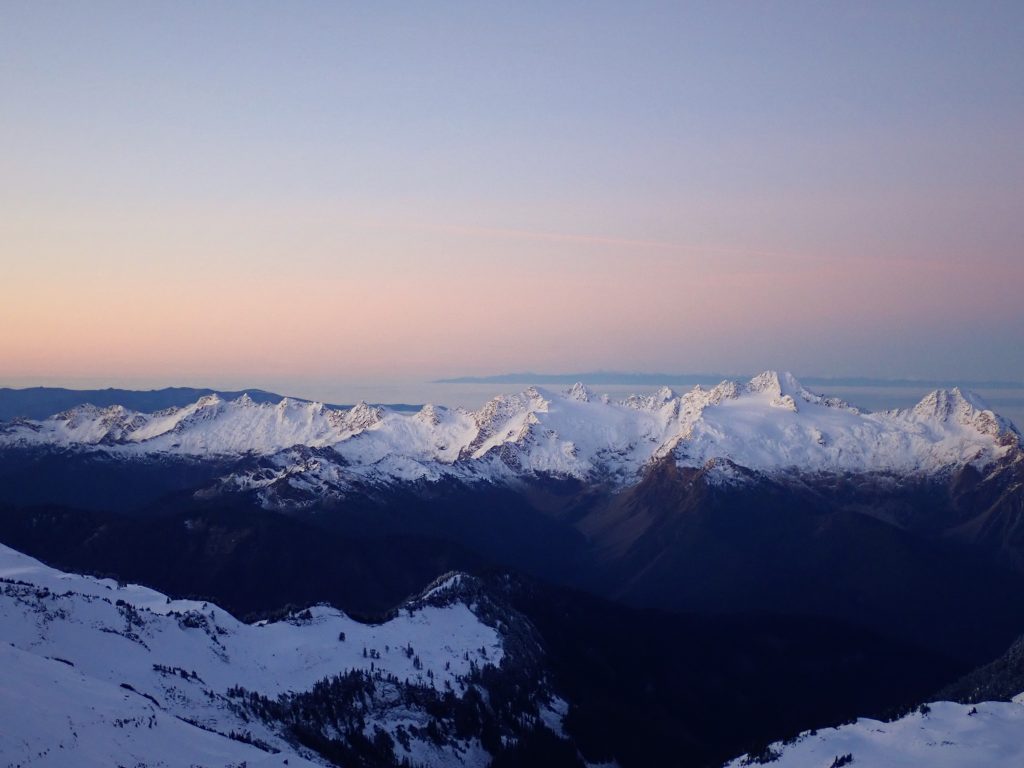
The man mentioned that he had talked to two ice climbers the day before who attempted Cosley Houston but turned back because they “couldn’t find the ice” on the first pitch. Andrew and I chuckled, not exactly sure what this meant. What it did mean is that there should be a boot pack or skin track to the base of the route!
At this point, it made most sense to rip our skins and take a short lap down to the glacier. We enjoyed beautiful silky powder for a few nice turns before arriving on the flatter section of the glacier.

From here, we roped up and followed the skin track towards Colfax. My friend Porter had given us good beta, finding that you need to stay lower and left on the approach to get around a monster crevasse. The existing skin track went this direction, so it worked out for us.
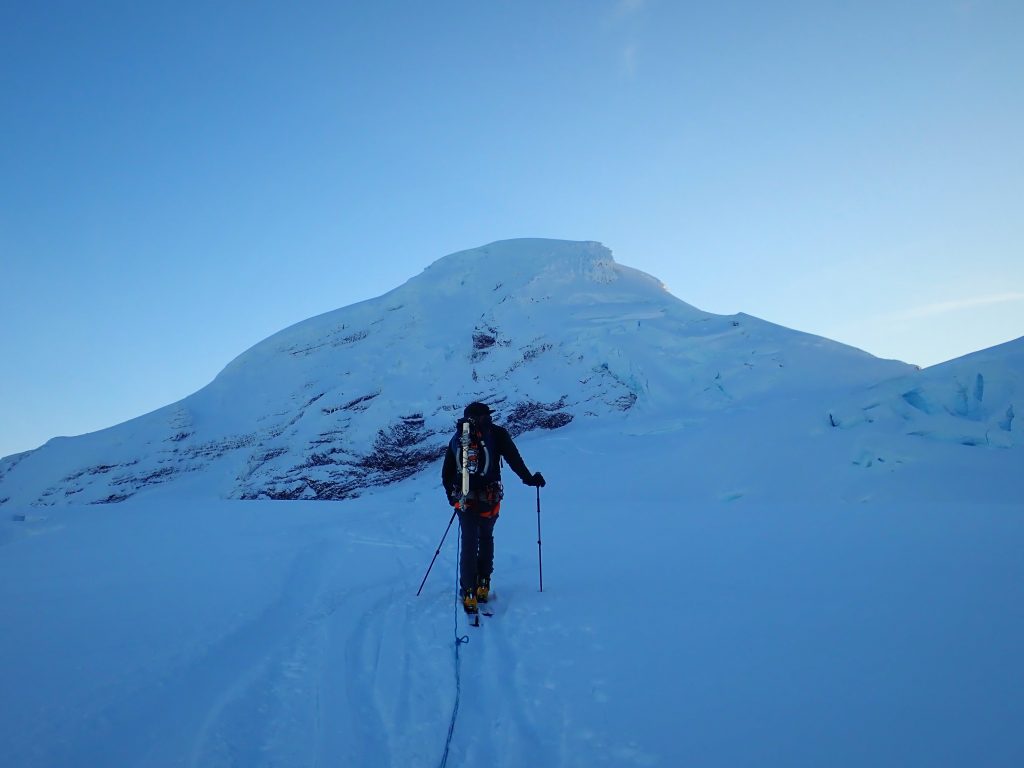
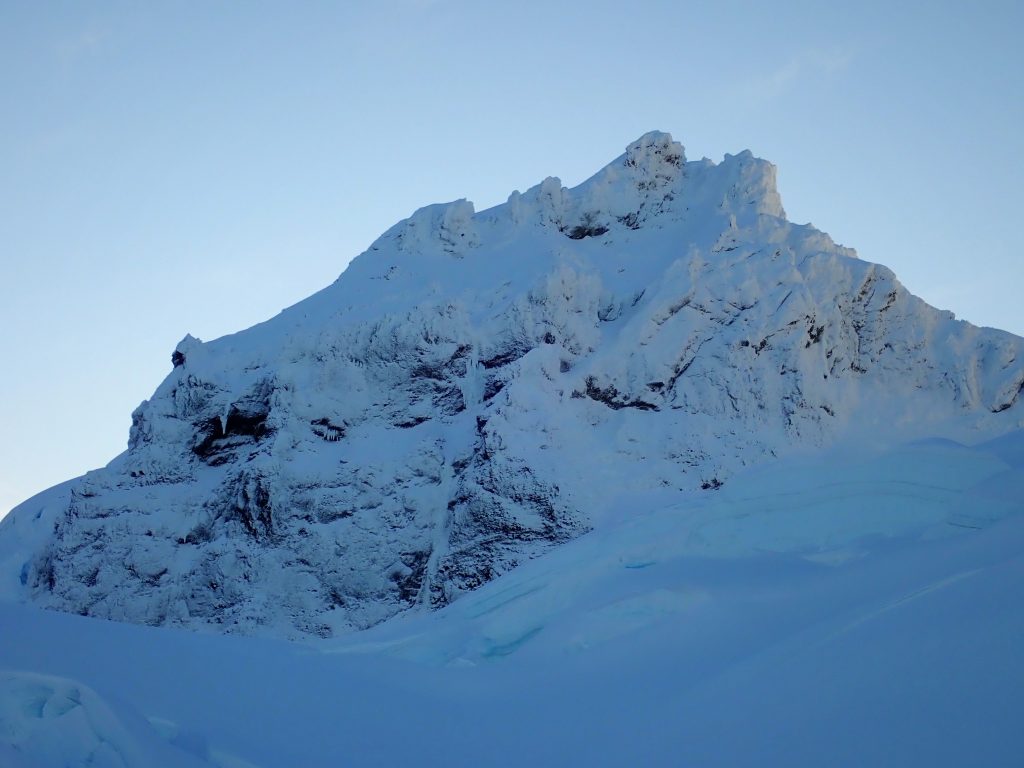
It is interesting how a glacier changes throughout the seasons. The Coleman was much more broken up than I had seen it in spring or summer, but the fresh powder was starting to obscure certain features. The signature black crumbly rock of the Black Buttes was all but cloaked in a fresh blanket of white.
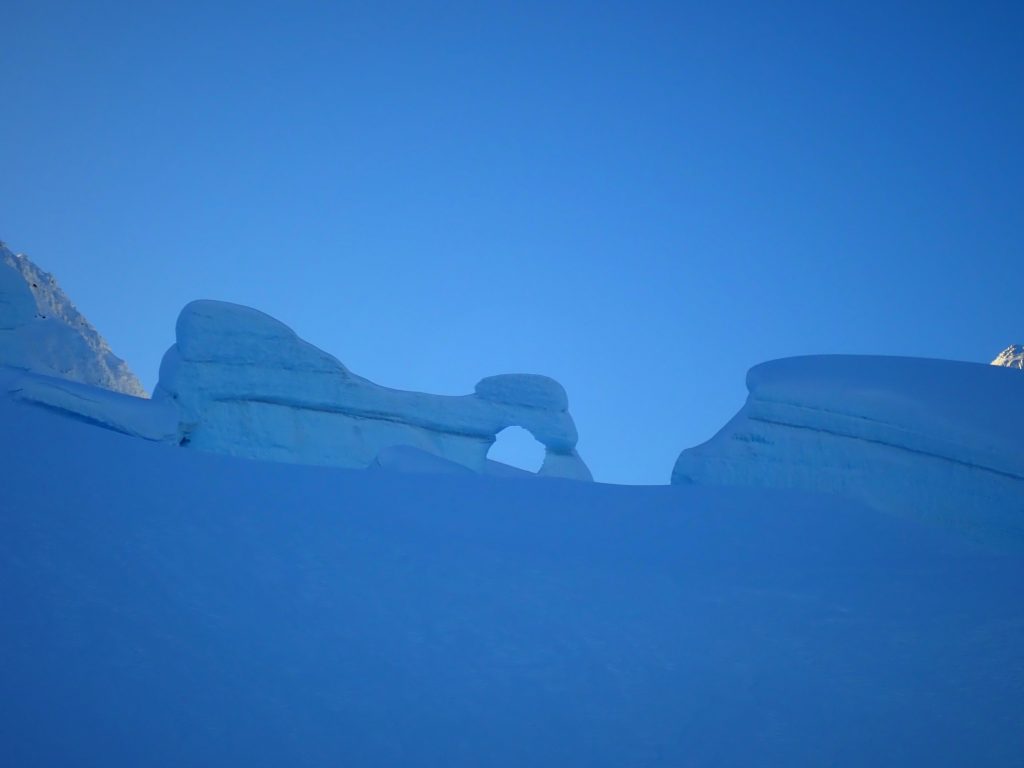
At a flat point around 8000 ft, we ditched the skis and started booting. We considered carrying skis over Colfax, but this would allow for easier climbing and the powder did not seem too deep anyways.
Unfortunately, much of the bootpack had been filled in by wind transport of snow. It was definitely a little slow and tiring, but at least we did not have too far to go. Frequent rest steps gave us ample opportunity to admire the cutting edge Polish Route (WI6!). As we turned the corner, that crux pitch started to come into view. Honestly, I tried not to look at it too much. I didn’t want to psyche myself out. The longer I’d look, the more doubt would creep into my mind. It is better to put the head down and keep moving.
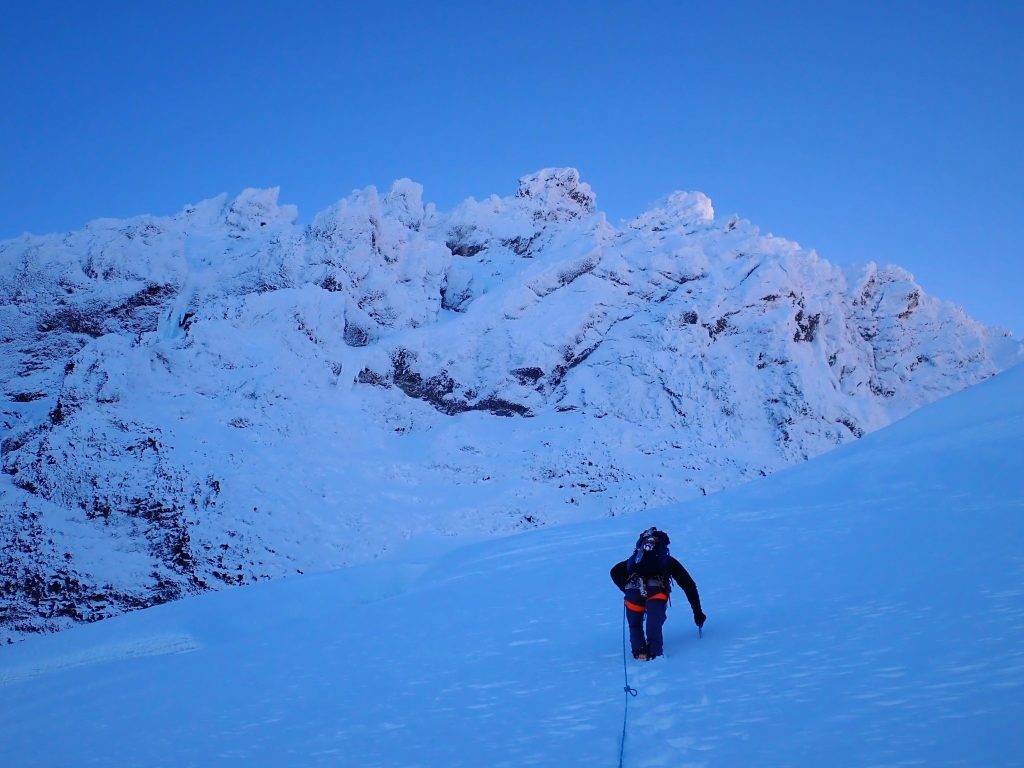
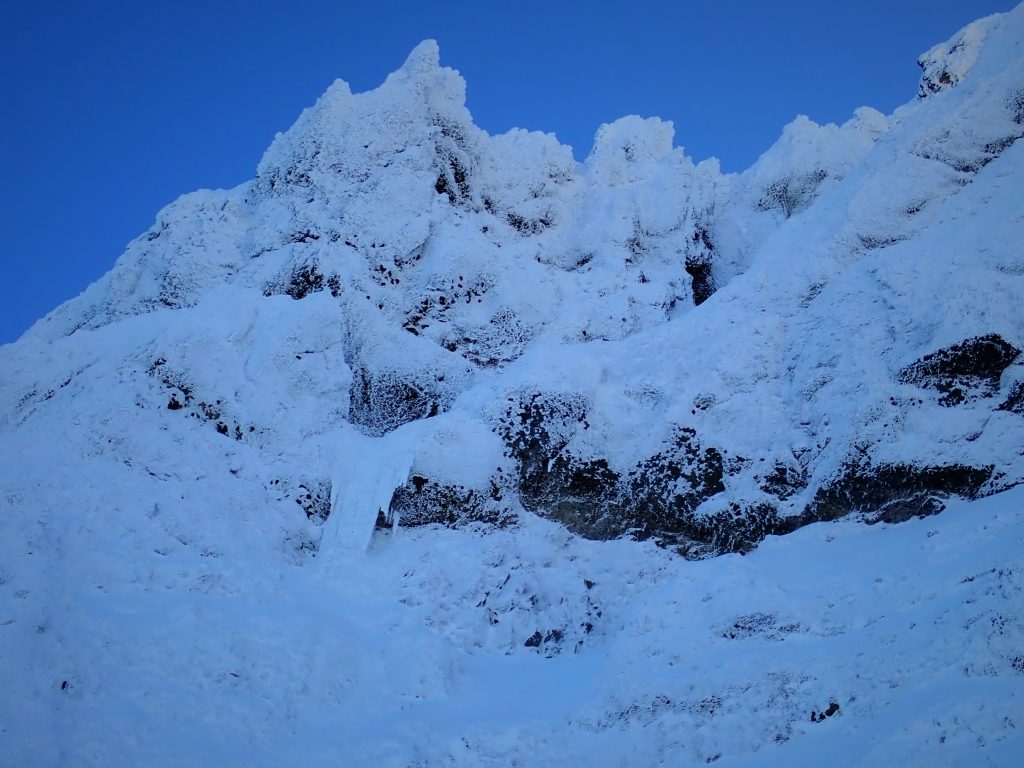
At the base, we racked up and Andrew took the lead. He had not climbed ice this season, but felt comfortable on the low angle stuff. He started at the most obviously depression at the top of the snowfield, and his first swing was straight into ice. I guess we had found the ice!

Andrew led quickly up left and then back right and was actually able to stretch the 60m rope to a screw belay at the left side of the base of the crux pillar.
As I reached the belay, I finally had a grasp of the steepness of the pillar. It was dead vertical – no, maybe slightly overhung. The ice was highly featured and chandiliered, although it was definitely in pretty fat conditions.
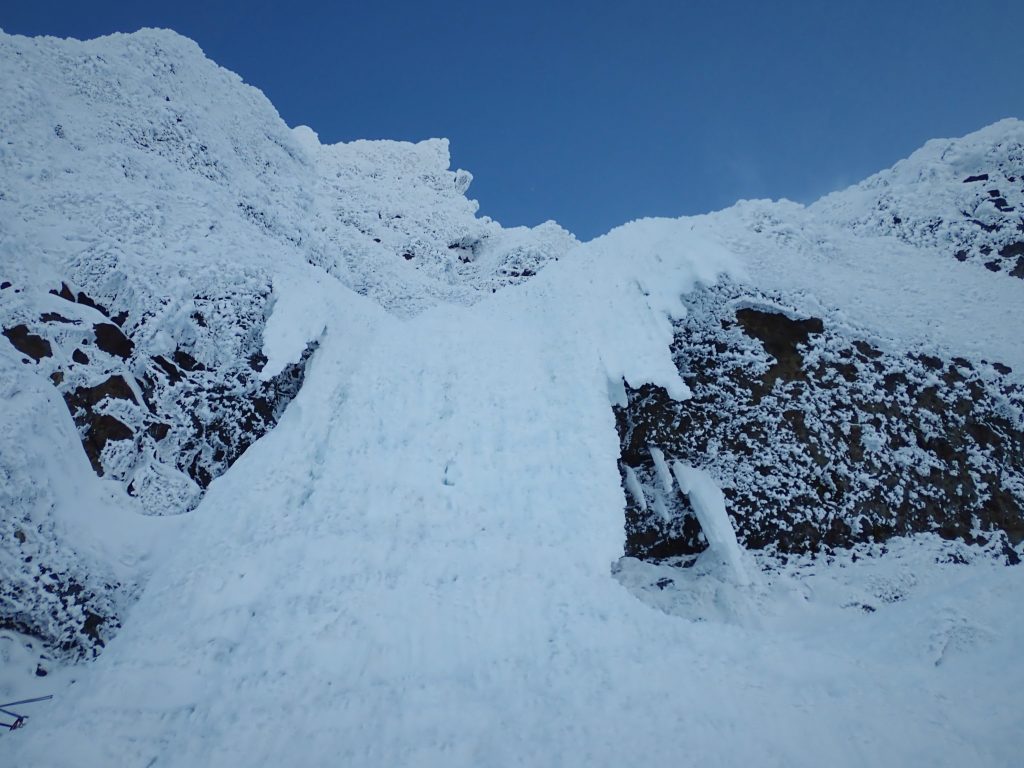
Andrew and I had talked the day before – if I had any second thoughts about leading this pitch, we would just rappel and head out, no shame. Even though I had not led anything like this, I knew I had the ability. We also had the screws to protect it well. So I figured I’d at least start up and assess the ice condition.
My first few swings were not encouraging – the ice fractured and large dinner plates fell onto my chest, threatening to knock me back. I was definitely considering backing down at this point, but instead I plugged in a screw and made a few cautious moves upwards. Every move was so slow and calculated, but I was not going to take any chances. Every stick and foot had to be bomber enough to hang from by itself.
As the ice steepened to vertical, the ice quality also improved. After just a few swings, I was able to get perfect, trustworthy sticks. And despite the varied features in the ice, I could find solid screw placements. Slowly, yet surely, I progressed upwards, battling the impending pump clock. Maybe I could have freed the entire pitch, but about halfway up, I decided to rest on a screw to keep the pump under control.
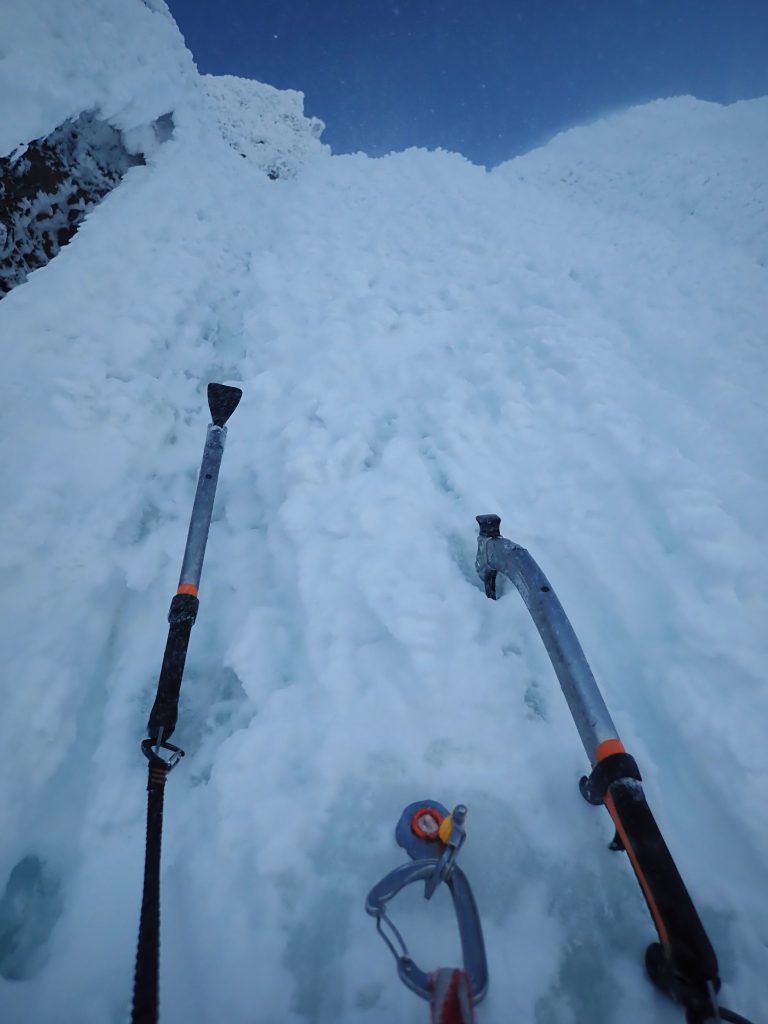
The pump clock when ice climbing is so much more visceral and imminent than while rock climbing. Placing a screw takes a substantial amount of time, so you cannot cut it too close. Each time I looked down, the belay was further and further below my feet. And each time I looked up, my sticks were ever closer to the top. I was moving so slowly, yet it almost felt like a blur; I was so focused on the task at hand.
After placing a total of 6 screws (and resting on about half of them), I finally pulled the bulge and progressed onto more moderate terrain. I set up a screw belay just below the final move since I knew that a strong belay would be difficult to setup after passing the last ice step. Calling “off-belay” down to Andrew was one of the proudest moments of my climbing career. I had just led a stout WI4 pitch in the alpine, in a way that felt safe and under my control.
Andrew had fun following the pitch (lucky guy!). He, too, had to rest while removing many of the screws but otherwise had little issues making it up. He continued up to the snowfield above and the I pulled the belay and soloed up to meet him.
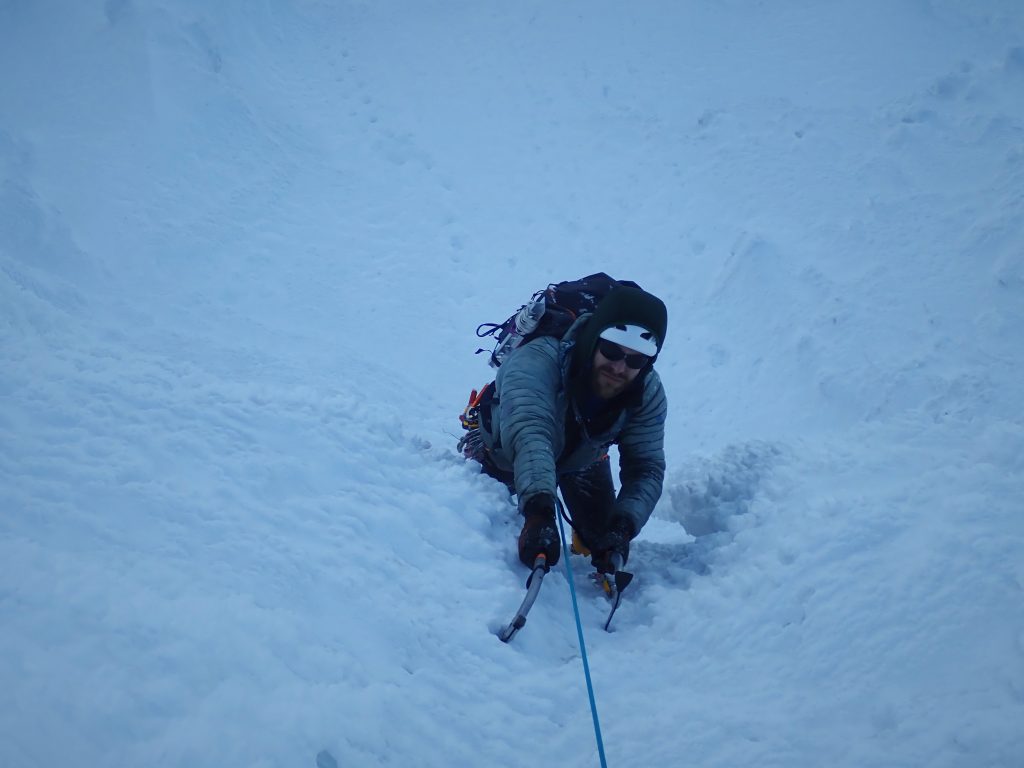
We are both confident snow climbers, so we put away the rope here and started booting up towards the second ice pitch. The gully was surrounded by sparkling walls of rime ice. Above, the bluest sky beckoned us upwards. It felt like a different planet.
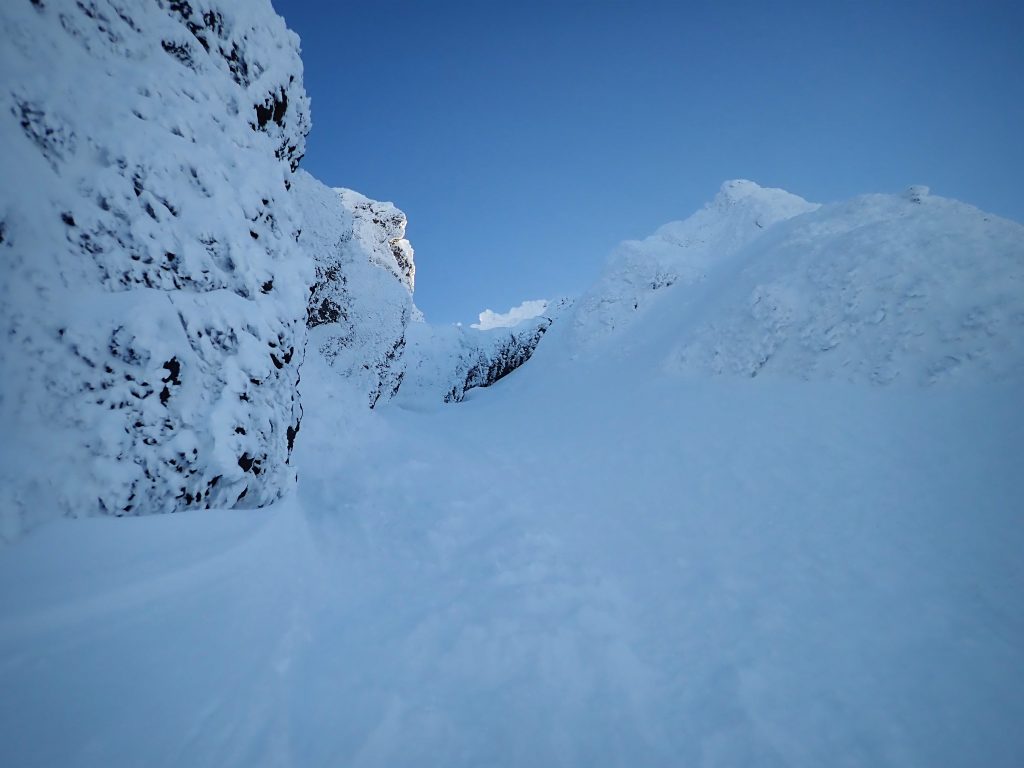
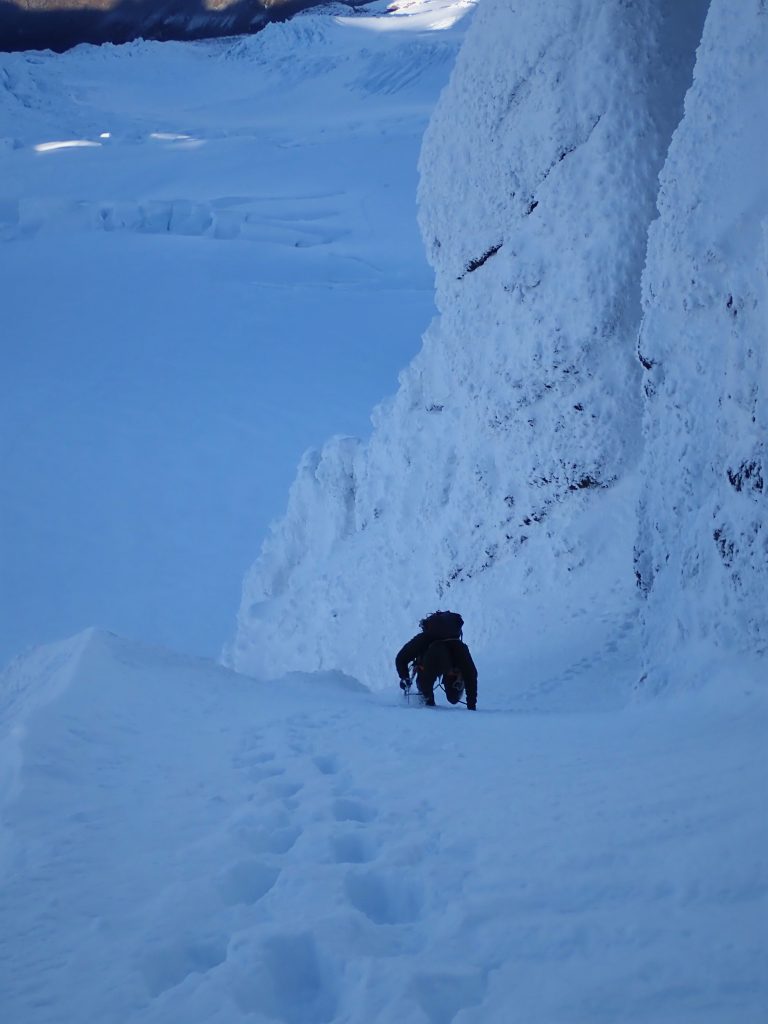
The second crux came sooner than we expected. However, it looked steep (read: vertical) with once again poor options for a solid top belay, so we decided to bypass it by taking some fun AI2 to the right. We traversed 60-70 ice up and around an exposed corner where the entire mountain seemed to drop away beneath us. So sick!
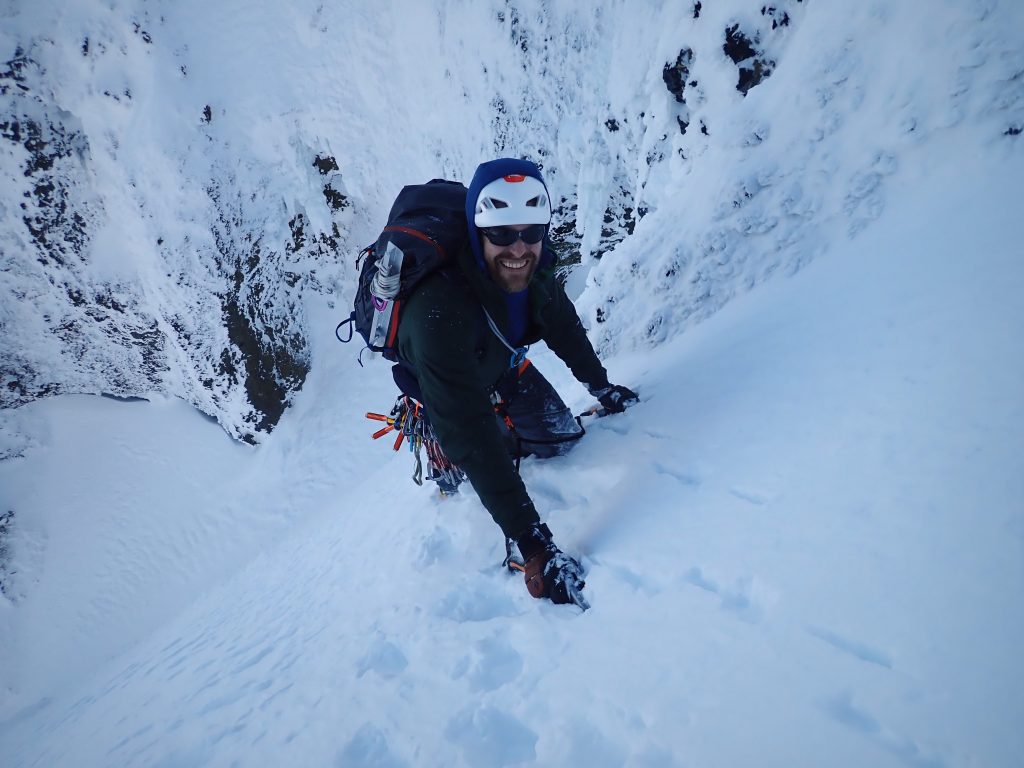
We entered the final snowfield, which was an impressive 50-60 degrees. The fresh powder actually made it easier to find rests from the otherwise relentless slope. We kept on motoring, the sprint to the finish.
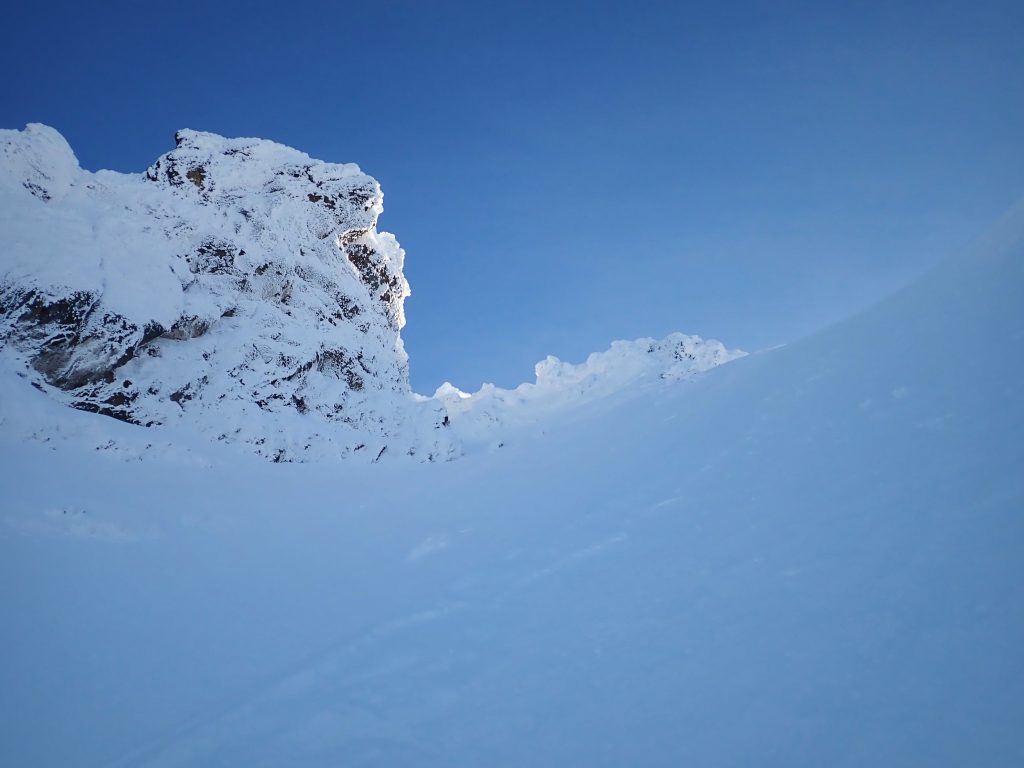
The were two obvious gullies I could take to exit. The left one probably led more directly to the summit, but the right one looked like less alpine ice and more just steep snow, so I headed that direction. At the very top, I peered over the edge to a short knife-edged snow traverse and then one final steep little push to the summit. The snow seemed a little wind loaded, but as I took a few steps along the ridge, I found secure footing. On the last little short steep section, my tools swung into rock and I groveled up to the top, ready to be on flatter ground.
I walked across the summit plateau and turned around. The gnarly spires of Lincoln Peak were framed through the various sub-summits of Colfax. With a fresh coating of snow, Lincoln looked like the peak in “How the Grinch Stole Christmas”. Beyond, Bellingham Bay and the Salish Sea remained shrouded in lowland fog on this fine, splitter December day.
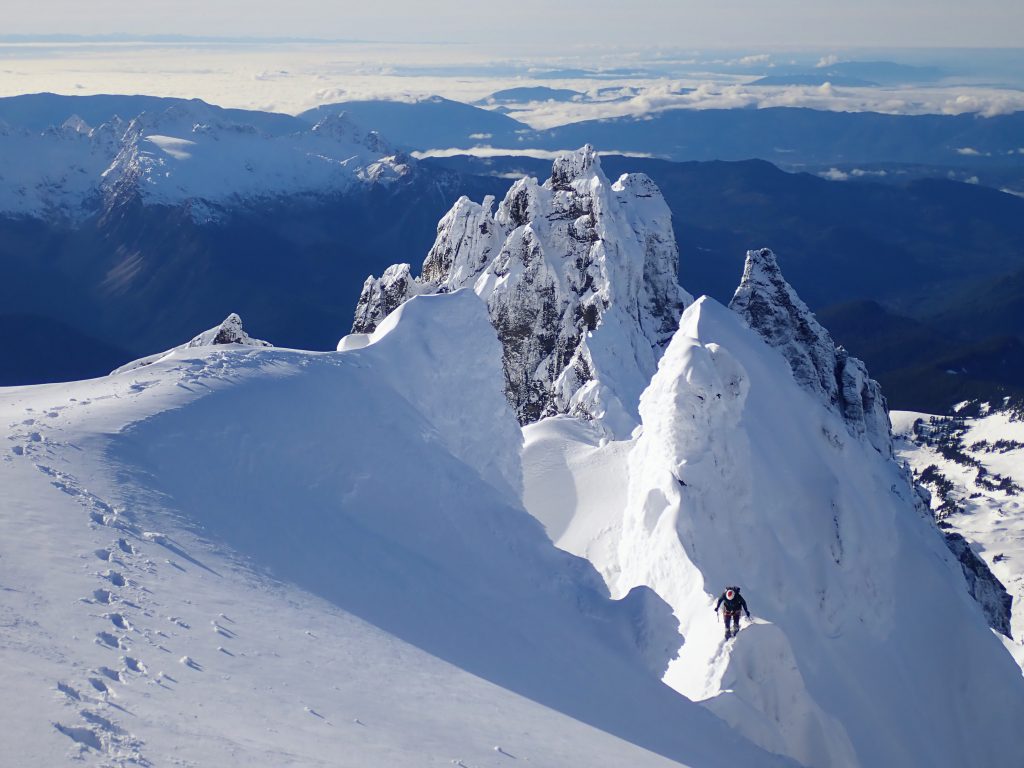
From my perch, I had a perfect view of Andrew finishing up the last bit of the climb.


Andrew let out a final whoop and we crashed down on the flat summit of Colfax. For the last few hours, we had been so laser focused, in no-fall terrain. It felt great to be able to relax and enjoy the December sun.
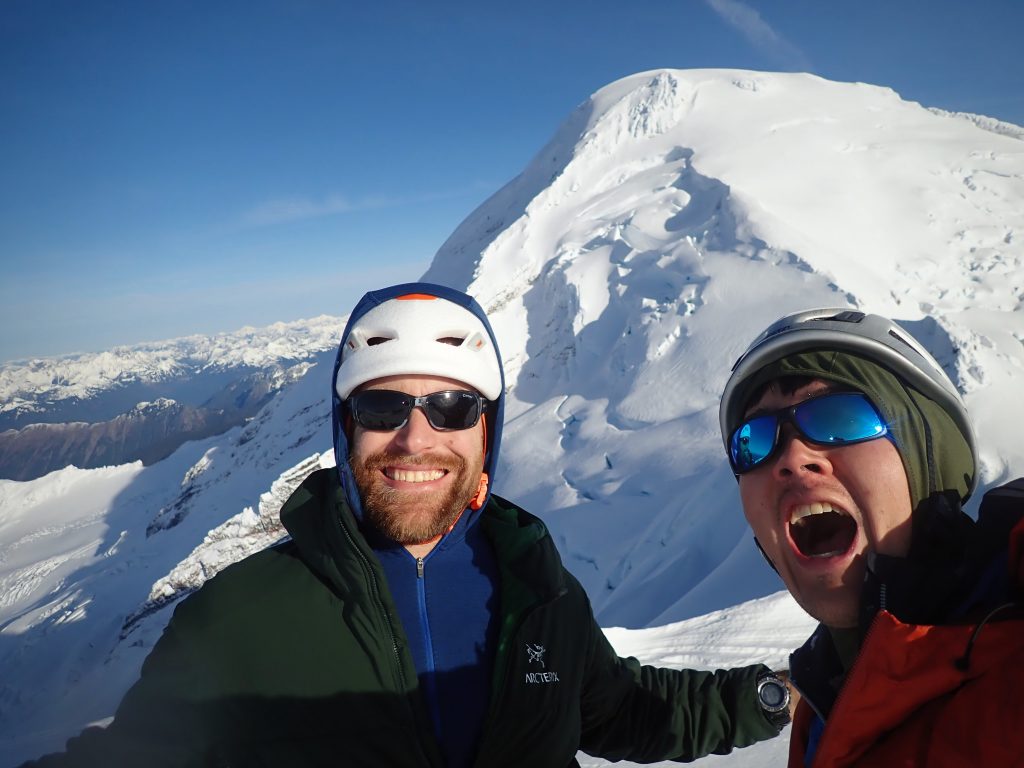
Kulshan looked so impressive from this angle, but what was really impressive was the clarity in the air, allowing us to see details in the distant Costal Range and Olympics.

The Black Buttes are some of the steepest, scariest peaks in Washington. From one point, I could peer down into the deep cirque of the terminus of the Easton Glacier some 4000 ft below. The choosy rock walls of the Black Buttes rose thousands of feet out of this cirque.

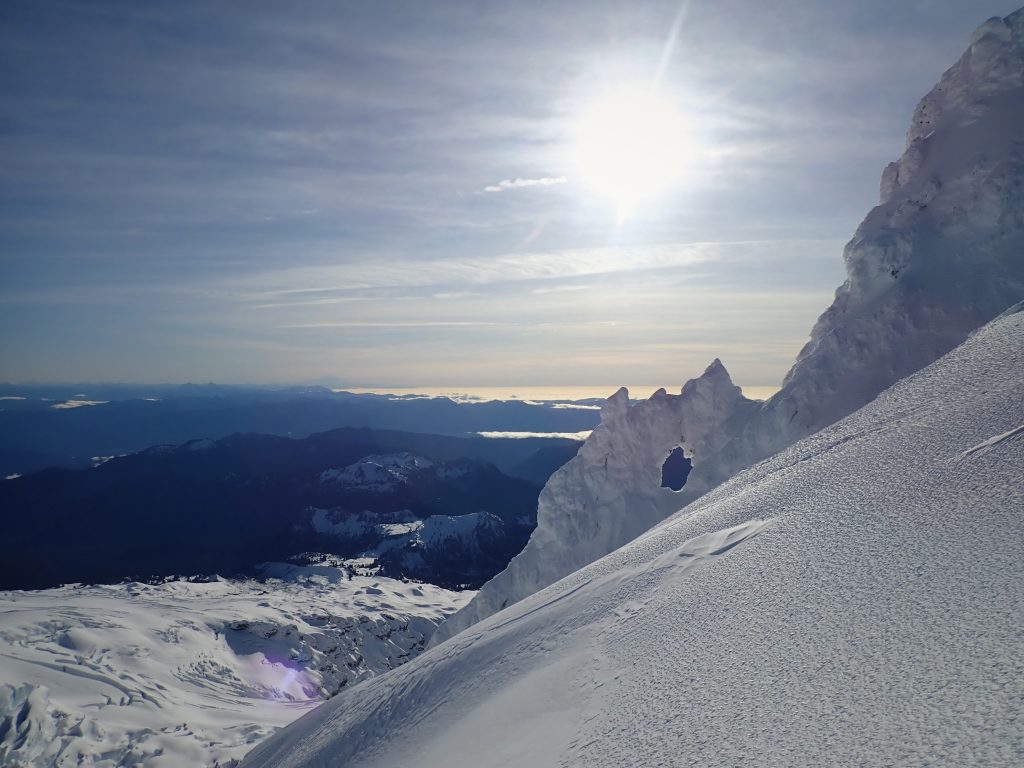
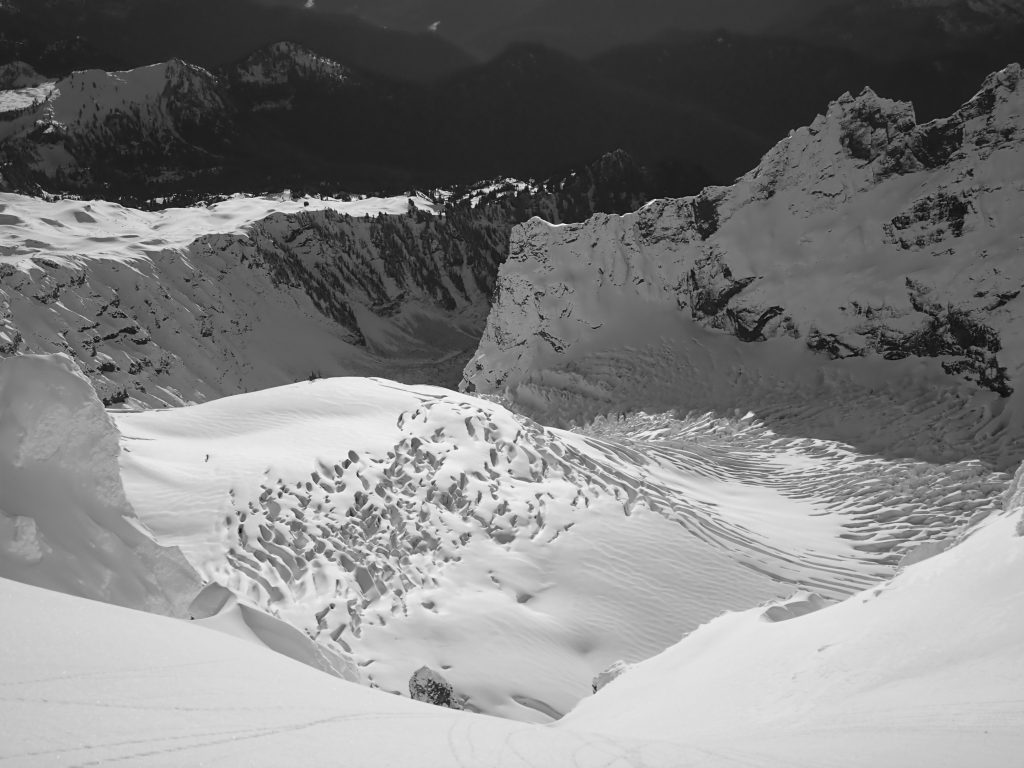
After a good rest, we got on our way, traversing towards the Colfax-Baker saddle. We had to zig zag some to get around crevasses and the final bergschrund on Colfax, but it was not too difficult.
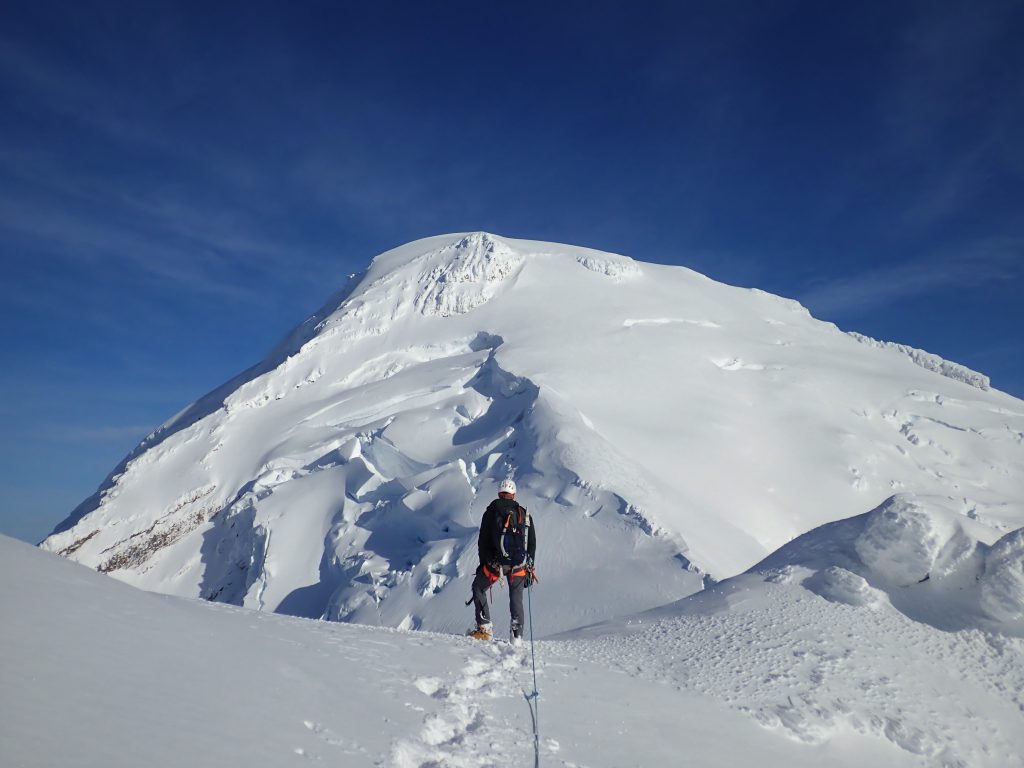
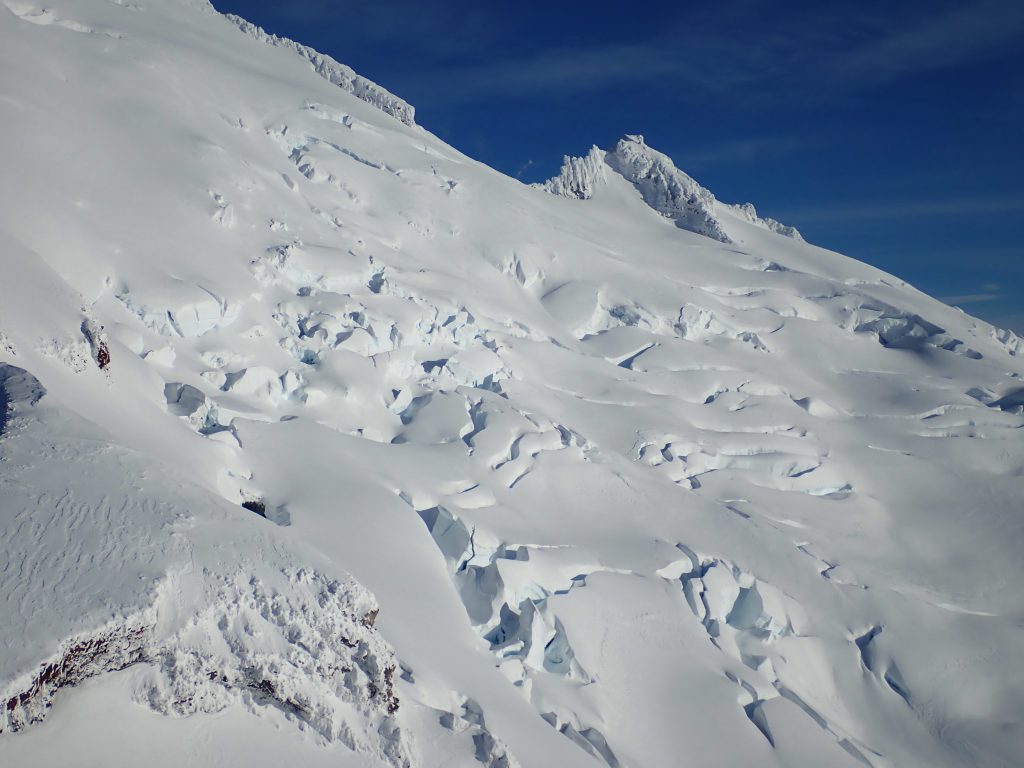
We knew that the descent of the upper Coleman Glacier could be one of the cruxes of the day. There was a bizarre monster crevasse that appeared in June last summer that spanned the entire Coleman! But Porter had reported that a bridge has already formed across the crevasse in one spot, so we knew we should be okay.
When descending a glacier, it is much more difficult to spot the bridges than while ascending. It is difficult to tell if a rollover leads to an ice cliff above a crevasse or just steep snow. We wandered for a while on the left side, but ended up trending skier’s right. There were two substantial crevasses, each with one key bridge! We had to go most of the way to the right side of the glacier to find these. It was nice to have a glacier guide like Andrew with me, since this was some of the more involved glacier travel I have ever done.
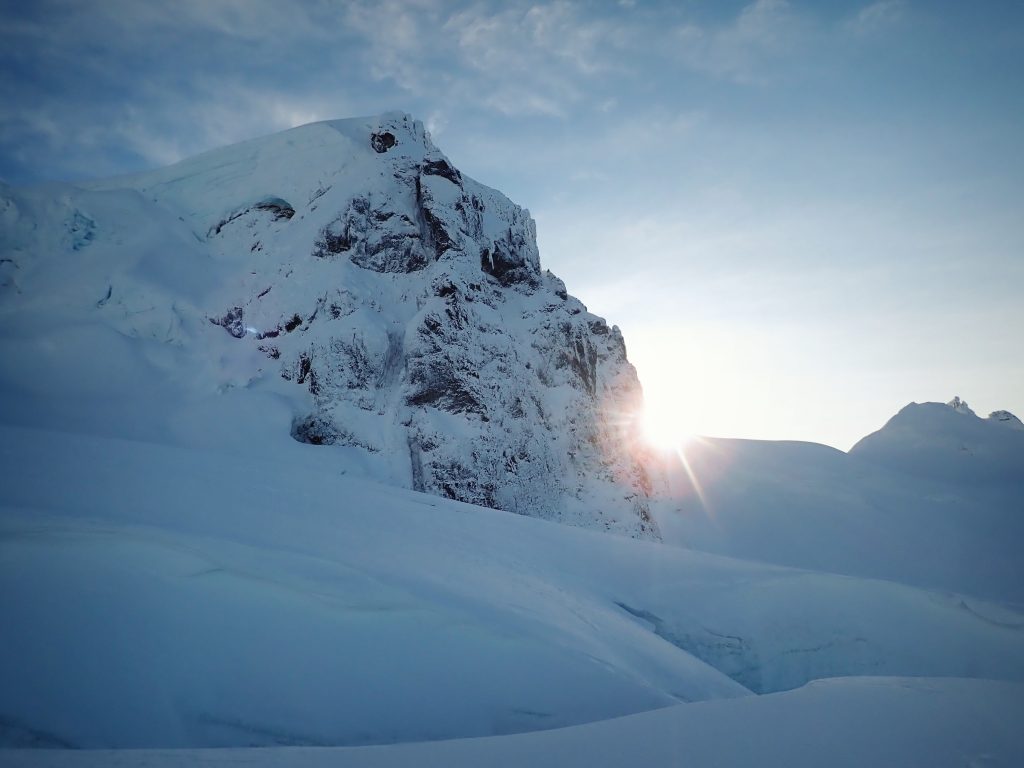
It was a great relief to reach our skis and know that the challenges of the day were mostly behind us. The focus of this trip was obviously ice climbing, but we knew we were also going to get some great powder skiing as a bonus!
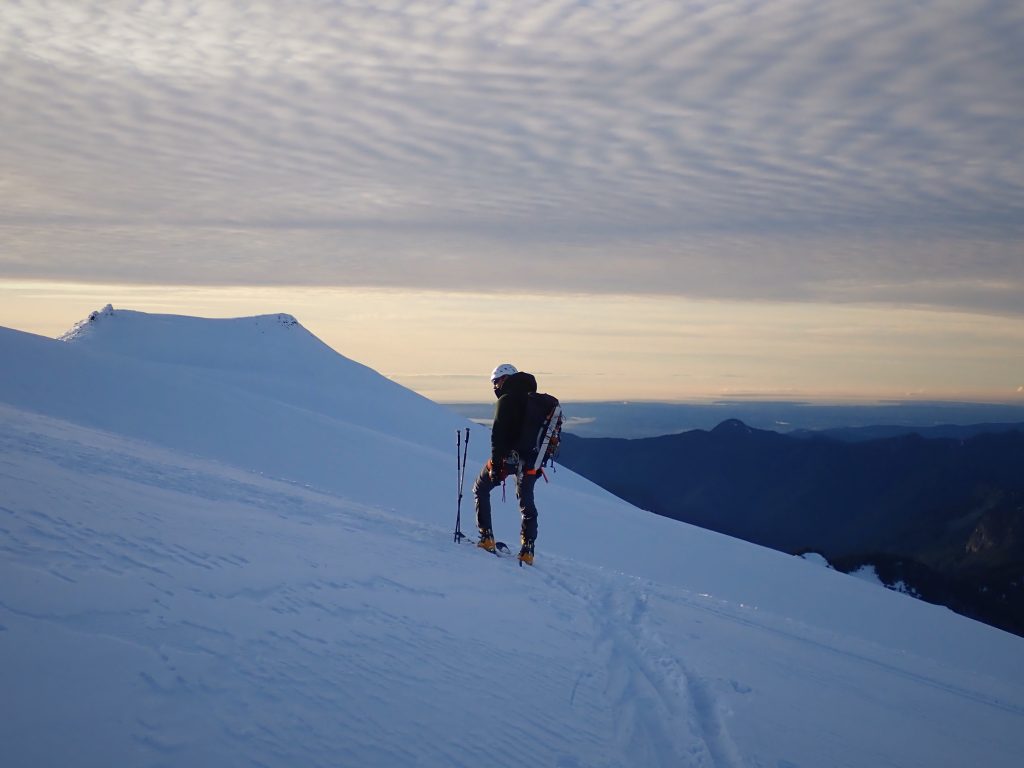
We zipped back down towards Heliotrope Ridge, put skins on briefly to get above some crevasses, and then ripped one last time. We carved buttery turns in the fading light. We got pow turns at sunrise and sunset, perfect bookends to a rad day in the alpine!
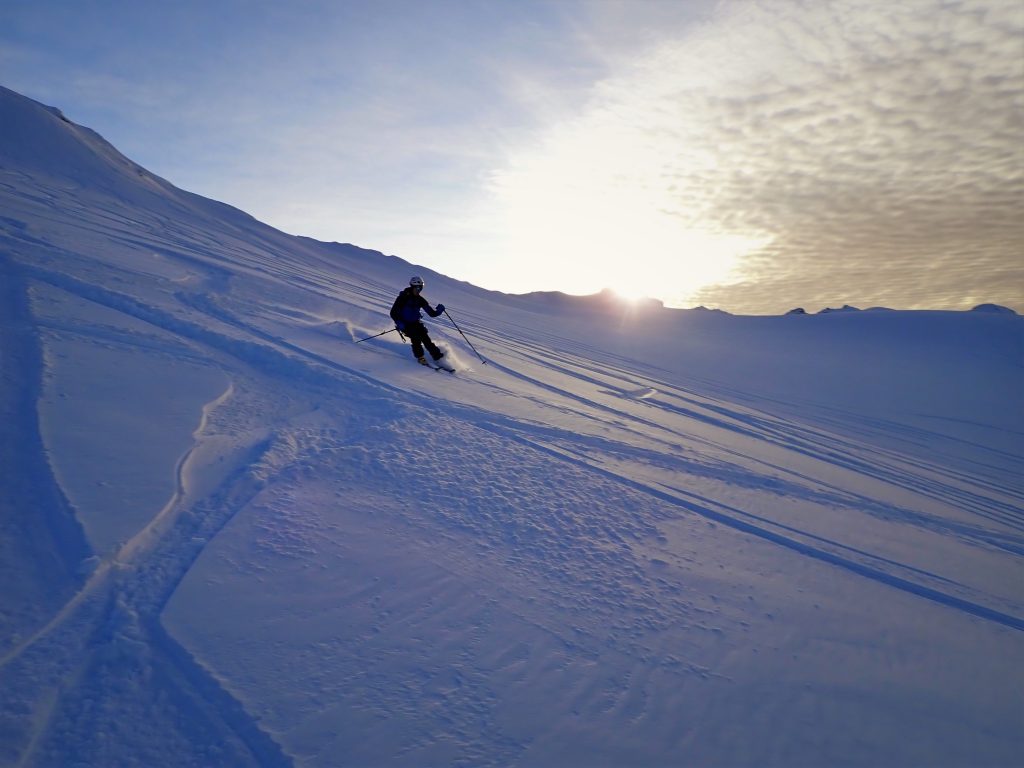
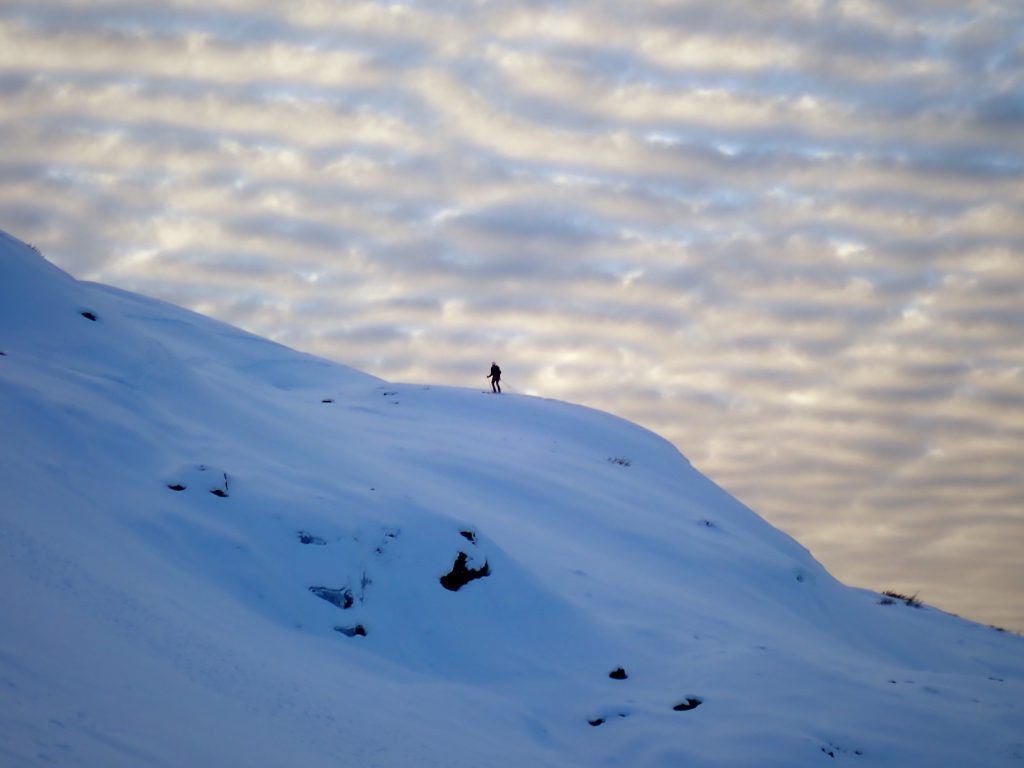
After picking up our stashed shoes, we were able to “ski” through the grass on a few inches of snow nearly all the way down to Heliotrope Trail! No shark bites were suffered!
After one last break to take off our ski boots and pack up, we finally headed out, slipping down the icy Heliotrope Trail, racing the impending darkness. We reached the car at 4:45 pm, just as headlights were needed, a full 12 hours after leaving the car.
Overall, this was such a stellar day in the alpine. Perfect weather, beautiful terrain, fun skiing, just enough cruxing to be interesting, and an awesome partner. Once again, it was so cool to climb a legit route with a new partner, which speaks volumes to the communication and skills both Andrew and I bring to the table. While Cosley-Houston is not the longest route, it features incredibly high quality and sustained climbing. It is certainly worthy of the reputation it receives.
In the last month, I climbed three big alpine ice routes and bailed on one other. Finally, I figured out how to make the most of the endless, frustrating shoulder season in the Cascades. As I write this, snow is finally dumping at the mid elevations in the Cascades and maybe winter is here for good. It felt like the mountains were teasing me, daring me to sneak in one last fall alpine climb. And so I took the challenge and threaded the needle, tiptoeing into the alpine, and then racing back to the lowlands before the Cascades become blanketed in their deep wintry coat.
Notes:
- The climbing is stiff on this route, especially in the fall. Top anchors can be difficult, depending on the snow conditions. The rock is terrible. For this reason, I’d recommend that both the leader and follower are solid at the grade before attempting it. I haven’t climbed a lot of WI4, so I cannot comment on the grade, but it was definitely harder than other 4s I’ve encountered in Hyalite. In our conditions, it was steep for about 15 feet, and then vertical or slightly overhung for another 15-20 feet.
- Make sure to give yourself time to descend the Coleman Glacier in the light. I would not have wanted to do that in the dark.
- We used 10 screws (2 at each belay, 6 on the crux). You could definitely use less, but we wanted to over-protect it. We did not use any rock pro or pickets because the snow conditions were too powdery.
- To minimize weight, next time I’d bring a 60m skinny rope and just double it over for the crux pitch.
- This route is often in condition from late October until May, but changes in character throughout the months. Be prepared for a variety of conditions.
- The Heliotrope Trail in the fall is the iciest trail I have ever been on, and the only trail where I have thought microspikes are a good idea.

Awesome trip report and fantastic photos!
Good decision making also, better to take a rest rather than fight the pump and take a whip.
Thanks! One should always swallow their pride and play it safe in the alpine.